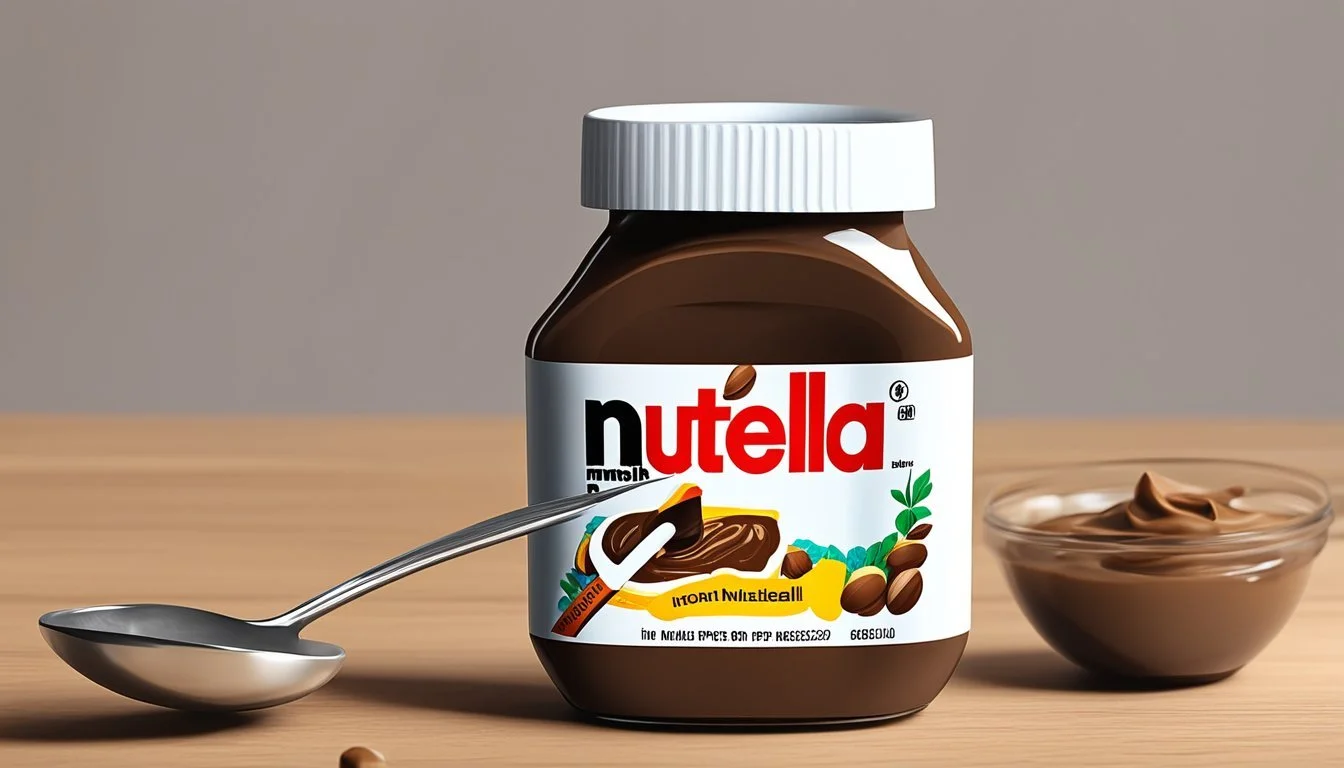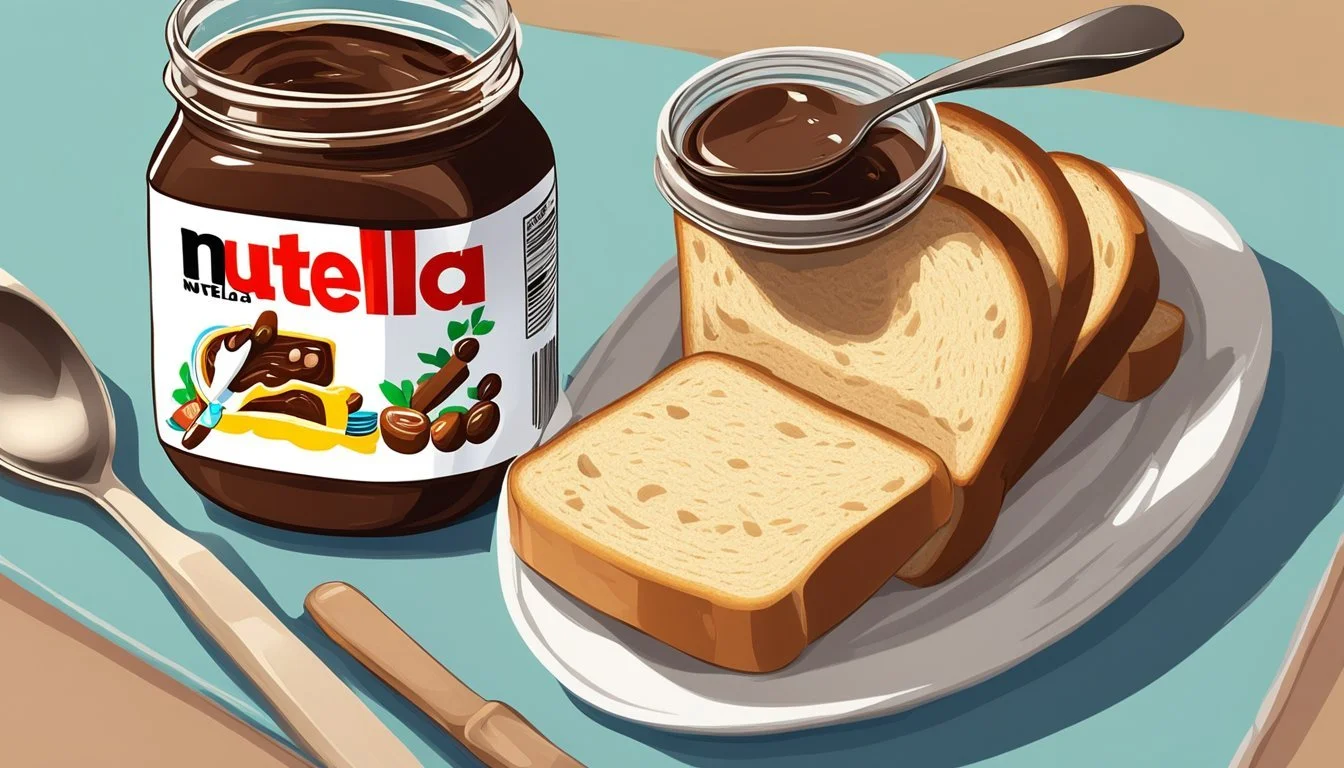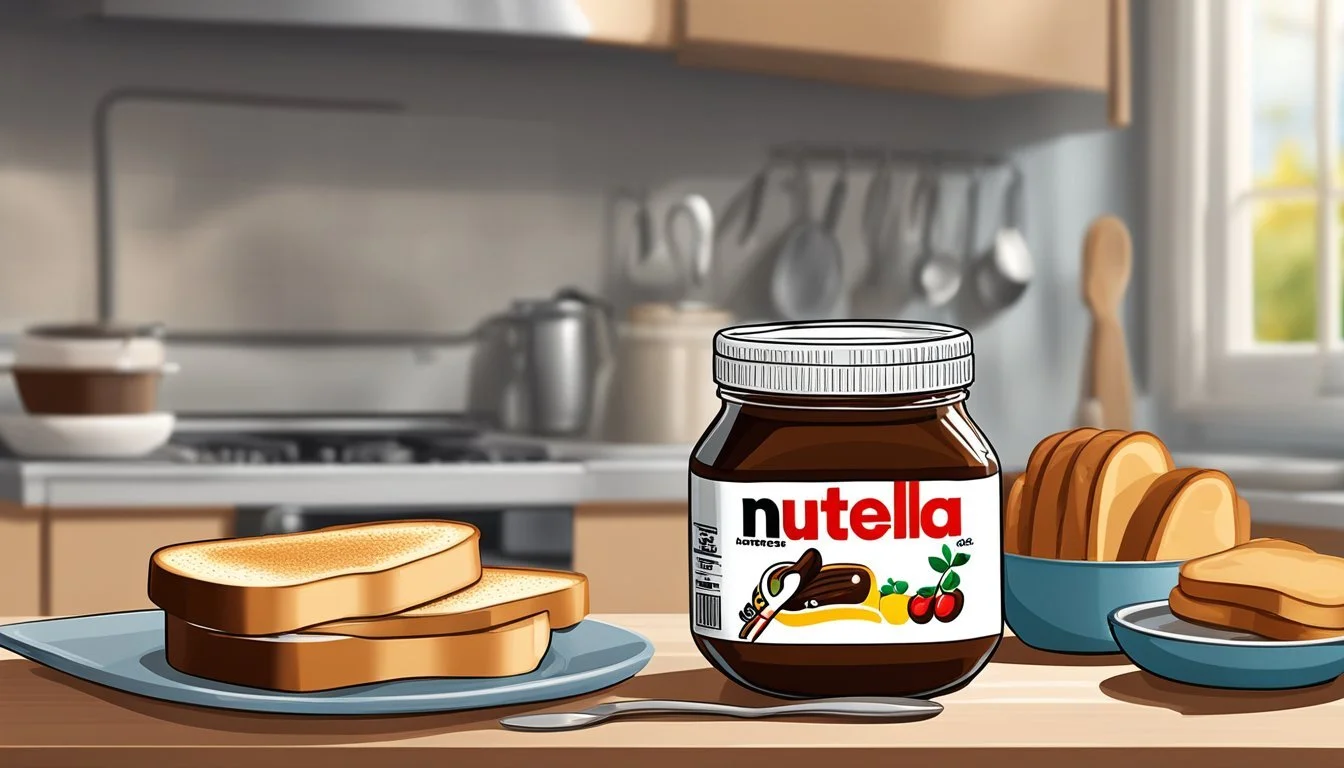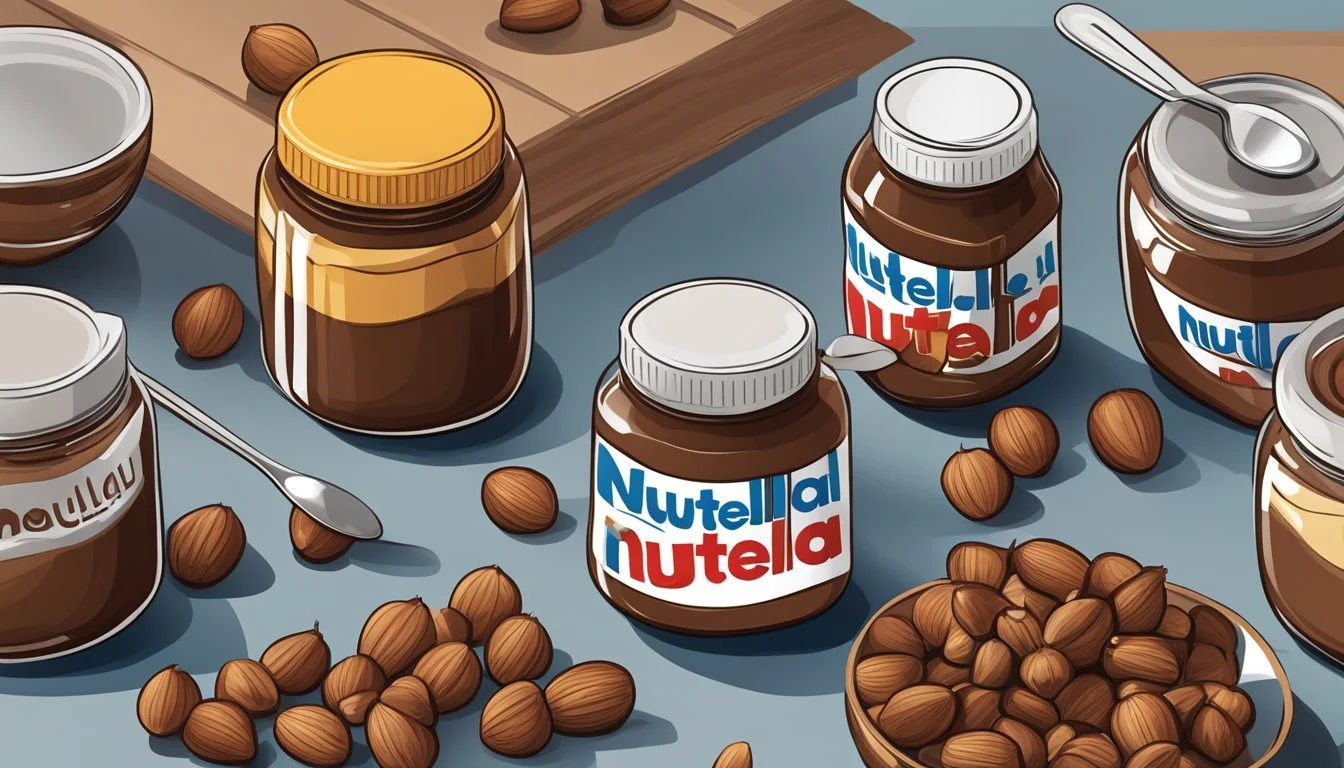How Much Nutella Hazelnut Spread Per Day Constitutes Overconsumption?
Nutella, a chocolate-hazelnut spread, has become a staple in many households, adored for its rich, creamy flavor. However, its nutritional content prompts a closer examination of its recommended consumption. Despite its delicious taste and the presence of hazelnuts, which offer some health benefits, Nutella is high in sugar and saturated fat. This profile suggests that moderation is key when incorporating Nutella into one's diet.
The average American adult and child's sugar intake sits significantly above the recommended limits, with added sugars amounting to approximately 19.5 teaspoons and 19 teaspoons per day, respectively. Nutella's sugar content contributes to this dietary consideration and thus, should be factored into an individual’s overall daily sugar consumption. Nutritionists advise that occasional consumption, such as once a week, is a more balanced approach to enjoying Nutella while maintaining a healthy diet. Portions should be kept at about 2 tablespoons or less to keep within reasonable limits of daily sugar and fat intake.
Understanding the balance between indulgence and nutritional health enables consumers to make informed decisions about their consumption of Nutella and similar hazelnut spreads. Although Nutella offers the protective benefits of hazelnuts, which can contribute to maintaining healthy cholesterol levels, these advantages may be overshadowed by the potential risks associated with its high sugar and saturated fat content when consumed in excess. Therefore, it’s important to weigh the taste and pleasure of Nutella against the nutritional considerations that come with its consumption.
Nutritional Profile of Nutella
Nutella is a sweetened hazelnut chocolate spread known for its rich taste. Its primary ingredients include sugar, palm oil, hazelnuts, cocoa, and skim milk. Here's a closer examination of its nutritional composition:
Calories: A two-tablespoon serving of Nutella contains approximately 200 calories, making it a high-calorie spread when consumed in large quantities.
Fat: Of the total calories, around 100 come from fat, with 11 grams of fat per serving. This includes a significant amount of saturated fat, influenced by the palm oil content.
Sugar: With around 21 grams of sugar per serving, Nutella has a high sugar content, contributing to its overall calorie density.
Nutrition: Despite being derived from hazelnuts, Nutella is not particularly rich in essential nutrients. It contains small amounts of calcium and iron but is relatively low in protein, providing only 2 grams per serving, and fiber, with less than 1 gram per serving.
Hazelnuts: They are a source of vitamins, minerals, and antioxidants, but their health benefits are offset in Nutella due to the high sugar and fat content.
Cocoa: Cocoa contributes to the chocolate flavor and contains some natural antioxidants, but the benefits are similarly outstripped by the less healthy components.
Nutella's consumption should be moderated due to its high sugar and fat content. Though it contains some beneficial ingredients like hazelnuts and cocoa, the nutritional benefits of these are minimized by the product's overall composition.
Recommended Serving Size and Daily Limits
In discussing the Nutella hazelnut spread, it’s essential to focus on both the recommended serving size and the daily limits for consumption. This section will dissect these aspects and offer a comparison with other popular spreads.
Understanding Portion Size
Nutella's serving size is typically two tablespoons, equating to approximately 37 grams. Acknowledging the correct portion size helps consumers maintain a balanced diet while enjoying the taste of Nutella. Overindulgence can lead to excessive intake of sugar and saturated fats, which are high in Nutella.
Daily Intake Recommendations
For a balanced diet, the American Heart Association suggests limiting added sugars to 36 grams for men and 25 grams for women per day. Considering Nutella contains a significant amount of sugar—21 grams in a serving—the spread should be consumed in moderation. It is prudent for an individual to factor in Nutella consumption within their daily caloric and sugar quotas to avoid surpassing recommended limits.
Comparative Analysis with Other Spreads
Compared to other spreads like peanut butter, almond butter, or cashew butter, Nutella has a higher sugar content and should be consumed less frequently as part of a balanced diet. Here is a brief comparison:
Peanut Butter: Generally contains about 3 grams of sugar per serving. High in protein.
Almond Butter: Typically lower in sugar, around 1-2 grams per serving, and rich in monounsaturated fats.
Cashew Butter: Similar to almond butter in sugar content, but often higher in saturated fat.
For individuals seeking healthier alternatives, almond or cashew butter might be a better choice due to their lower sugar and higher nutritious value. However, when it comes to indulgence or flavor preferences, a minimal amount of Nutella could fit into a balanced dietary pattern.
Health Considerations and Risks
Nutella's sugary and fatty composition necessitates moderation, particularly for individuals with certain health conditions, or those aiming for a balanced diet. Here's what consumers should be aware of:
Sugar and Fat Content
Nutella's primary ingredient is sugar, and one two-tablespoon serving contains 21 grams of sugar and 200 calories. The American Heart Association recommends a limit of 24 grams of added sugar per day for women and 36 grams for men. The same serving size of Nutella also provides 18 percent of the recommended daily value of fat. Excessive intake of these macronutrients can lead to health issues such as:
Weight Gain: Frequent consumption of high-sugar, high-fat foods can contribute to an increase in body weight.
Obesity: Over time, excessive caloric intake can lead to obesity, an established risk factor for numerous diseases.
Childhood Obesity: High sugar diets are particularly concerning for children, as they can lead to lifelong health challenges.
Potential Impact on Conditions
Entirely devoid of potassium, a nutrient essential for heart health, Nutella instead may exacerbate certain medical conditions. Its high sugar content is worrisome for those with diabetes, as it can cause spikes in blood sugar levels. For individuals concerned about heart disease, the saturated fat in Nutella can affect cholesterol levels negatively.
The concerns extend to:
Diabetes: It's essential to manage sugar intake to avoid blood glucose fluctuations.
Heart Disease: Managing dietary fats is crucial to prevent worsening heart health.
Cholesterol: High-fat foods can raise LDL (bad) cholesterol, increasing heart disease risk.
Nutella in a Balanced Diet
Inclusion of Nutella should be in moderation within a balanced diet that contains a variety of nutrients. While Nutella offers minimal health benefits in terms of nutrient content, it can be part of a diet that aims at disease prevention when consumed sparingly. However, overreliance on such processed foods may detract from intake of nutrient-dense foods necessary for overall health.
Culinary Uses of Nutella
Nutella hazelnut spread provides a creamy texture and rich flavor, making it a versatile ingredient in various recipes. From traditional pairings to innovative culinary creations, Nutella can enhance the taste and consistency of different dishes.
Common Recipes and Pairings
Nutella's creamy consistency and sweet taste make it a popular choice for spreading on toast, enhancing the flavor of pancakes and waffles, and complementing maple syrup as a topping. Its versatility extends to various snacks and desserts where it is often used as a filling or spread.
Toast: A layer of Nutella elevates the simple breakfast staple.
Pancakes/Waffles: It serves as a decadent substitute for traditional syrups.
Sandwich: Combine Nutella with fruits like bananas or strawberries for a quick snack.
Creating Homemade Nutella
Those preferring a homemade version with potential variations in nut content can create a Nutella-like spread using raw hazelnuts or even pecans for a different flavor profile. The basic steps involve roasting nuts, blending them into a butter, and incorporating ingredients such as sugar, oil, and cocoa.
Roast raw hazelnuts at 350°F until fragrant, about 8-12 minutes.
After cooling, remove the skins by rubbing the hazelnuts in a towel.
Blend into a butter and add cocoa powder and sweeteners to achieve a similar Nutella consistency.
Dietary Alternatives and Modifications
For those with dietary restrictions, various modifications can be made to the traditional Nutella recipe. Dairy-free and reduced-sugar options can cater to specific dietary needs while still providing the characteristic creamy texture of Nutella.
Dairy-Free: Substitute any dairy ingredients with plant-based alternatives.
Pecan Nutella: Use pecans in place of hazelnuts for a different but equally delicious spread.
Reduced-Sugar: Adjust the quantity or types of sweeteners to lower the sugar content.
Each adaptation maintains the spirit of Nutella while allowing for personal customization whether used in baking or as a snack.
Storage and Handling of Nutella
Properly storing Nutella ensures its longevity and preserves its quality. Below are the techniques and factors to consider for maintaining Nutella's freshness.
Proper Storage Techniques
Location: Nutella should be stored in a cool, dry place, away from direct sunlight and heat sources. A pantry or cupboard at room temperature is ideal.
Container: Once opened, Nutella must remain in its original container with the lid tightly closed to prevent moisture and other contaminants from spoiling the spread.
Refrigeration: While it’s not necessary to store Nutella in the fridge, doing so may extend its shelf life somewhat; however, refrigeration can affect the spread's consistency, making it harder to spread.
Shelf Life and Signs of Spoilage
Shelf Life:
Unopened Jar: An unopened jar of Nutella can retain its quality for up to two years when stored correctly.
Opened Jar: After opening, Nutella generally remains fresh for up to twelve months.
Condition Expected Shelf Life Unopened, pantry stored Up to 2 years Opened, pantry stored 6 to 12 months
Signs of Spoilage:
Smell and Taste: Should Nutella give off an unusual odor or taste significantly different, it may be spoiled.
Texture: Changes in texture, such as becoming too hard or liquid, could indicate spoilage.
Mold: Any visible mold growth means the Nutella should not be consumed.
Consumer Information
In this section, the focus is on the branding and manufacturing details of Nutella hazelnut spread as well as addressing frequently asked questions and dispelling common myths associated with this popular product.
Branding and Manufacturer
Nutella is a brand of hazelnut spread that is widely recognized around the globe. The spread is produced by Ferrero, an Italian manufacturer known for its various confectionery and chocolate products. Ferrero maintains a consistent brand image for Nutella, promoting it as a quick and tasty ingredient often used in breakfasts and snacks.
Nutella's composition typically includes sugar, palm oil, hazelnuts, cocoa solids, milk powder, lecithin, and synthetic vanillin. The product varies slightly from region to region, with the Italian Nutella often cited as having a higher hazelnut and cocoa content compared to the American version of the spread.
FAQs and Myths
Is Nutella healthy?
This is a common question consumers have about Nutella. The spread contains significant amounts of sugar and fat, which contributes to its high calorie count. In the context of a balanced diet, Nutella should be consumed in moderation. According to the American Heart Association, adults should limit their intake of added sugars to no more than 6 teaspoons (25 grams) per day for women and 9 teaspoons (38 grams) for men.
Common Myths:
Myth: Nutella is a good source of protein.
Reality: The hazelnut content does provide some protein, but it is not a significant source when consumed in the amounts generally used as a spread.
Myth: Nutella is a chocolate spread.
Reality: Although Nutella contains cocoa, it is not predominantly chocolate. It's a hazelnut spread with cocoa flavoring.
Nutella's labeling and marketing often present it as part of a balanced breakfast, usually accompanied by fruit, bread, and healthy beverages. However, its high sugar content and caloric density mean that it can contribute to excessive calorie intake if not consumed in small quantities.
Environmental and Ethical Considerations
When evaluating the consumption of Nutella, one must consider the environmental and ethical implications tied to the production of its key ingredients. These factors contribute significantly to the broader impact of enjoying this popular hazelnut spread.
Ingredients Sourcing
The supply chain for Nutella's ingredients is extensive, with hazelnuts, cocoa, and palm oil being sourced from various parts of the world. Hazelnuts are predominantly sourced from Turkey, which produces about 70% of the global supply, followed by countries like Italy, Chile, and the USA. Sourcing from different regions can impact local ecosystems and farming communities.
Hazelnut: Climate change poses a risk to hazelnut production, particularly in regions heavily reliant on this crop.
Cocoa: Ethical and sustainable sourcing of cocoa is critical due to the concerns around labor practices in cocoa farming.
Palm Oil and Deforestation
The use of palm oil in Nutella has raised concerns due to the environmental impact associated with palm oil production, one of the leading causes of rainforest deforestation. The company has made commitments to sustainability, emphasizing the use of palm oil certified by the Roundtable on Sustainable Palm Oil (RSPO).
RSPO Certification: Ensures that standards for producing sustainable palm oil are met.
Environmental Impact: Deforestation leads to loss of habitats and contributes to climate change.
Through its commitments, the brand seeks to balance the pleasure of its product with responsible sourcing and production practices.
DIY Nutella and Alternatives
Making your own Nutella-like spread is a way to control the ingredients and portions. For those aiming for a healthier alternative, a homemade version can be tailored to dietary preferences, such as dairy-free or organic options. A food processor or blender is essential for achieving a smooth paste, vital for mimicking the texture of traditional Nutella.
Ingredients & Process
Homemade Nutella usually contains:
Hazelnuts
Cocoa powder
Sweeteners (like coconut sugar)
Oil (often coconut or a hazelnut's own oil for creaminess)
Optional: Vanillin or natural vanilla for flavor
Hazelnuts are typically processed until they release their oils and form a paste.
Other ingredients like cocoa powder and sweeteners are added and blended until smooth.
Alternatives to Consider
For those who don't have a food processor, there are alternatives on the market that use organic ingredients and avoid palm oil, which can help support environmental sustainability. Some commercial varieties might include soy lecithin as an emulsifier, something to bear in mind for anyone with soy allergies.
Noteworthy Inclusions for Variation:
Strawberries: For a berry twist, add freeze-dried strawberries into the mix.
Dairy-free milk: A splash can be added to homemade spreads to achieve desired consistency.
Pro Tip: Regularly scrape down the sides of the food processor to ensure an even blend. Patience is key, as the process can take upwards of 20 minutes.
This approach to making a Nutella alternative at home allows for customization and potentially healthier spreads that cater to individual dietary needs and preferences.
Nutella in Popular Culture
Nutella has cemented its place not only on breakfast tables but also in popular culture. Social media platforms like Instagram and Pinterest abound with images and recipes featuring this well-loved hazelnut spread, showcasing its power to engage communities around comfort food and creative culinary practices.
Instagram: Influencers frequently post aesthetically pleasing photos of Nutella jars alongside artfully prepared breakfasts, amassing likes and shares.
Pinterest: A treasure trove for Nutella-fueled creativity, with boards dedicated to recipes ranging from simple Nutella toast to elaborate desserts.
Nutella's widespread popularity can also be attributed to the energy it provides as a comfort food that resonates with a broad audience, solidifying its status as a cultural phenomenon.
Celebrity chefs and food bloggers often experiment with Nutella, integrating it into traditional recipes to give them a modern twist, while food festivals sometimes feature Nutella as a key ingredient in innovative dishes.
Moreover, the brand's marketing strategies harness the speed of internet culture to address consumers' craving for quick yet delicious snacks. With engaging online campaigns, Nutella maintains a dynamic presence in the digital realm.
Nutella-related research has often focused on its consumer reach and impact, exploring how the brand's prevalence in pop culture reflects changing tastes and food trends.
In summary, through a blend of consumer affection, digital engagement, and culinary versatility, Nutella thrives within the arena of popular culture, tapping into the zeitgeist with a mix of nostalgia and a nod to modern food exploration trends.
Nutella-Related Health Research
Nutrition and health research on products like Nutella has highlighted the importance of moderation due to its high sugar content. Nutella contains 21 grams of sugar per serving, which is a significant portion of the American Heart Association's recommended daily maximum of 25 grams for children. Adults consume an average of 19.5 teaspoons (82 grams) of added sugar per day, far exceeding recommended limits.
Nutrient Amount per Serving (2 tablespoons) Calories 200 Sugar 21 grams Total fat (Saturated fat) 18% of recommended daily value
The research indicates that overconsumption can contribute to a variety of health issues, including heart disease due to high levels of saturated fats. It's also noteworthy that Nutella provides a quick energy boost from its sugar and fat content; however, this is often accompanied by a rapid drop in blood sugar levels, leading to decreased energy later.
In terms of disease prevention, products high in added sugars and saturated fats, such as Nutella, are not typically associated with positive outcomes. While Nutella does contain hazelnuts, which are a good source of vitamins and monounsaturated fats, the relatively small percentage in the spread (about 13% for Italian Nutella) does not significantly contribute to its nutritional profile.
In conclusion, given the high sugar and fat content in Nutella, moderating intake is essential. Consumers looking for health benefits are advised to consider spreads with higher nut content and lower added sugars and fats for better nutrition and disease prevention.
Frequently Asked Questions
What is the recommended serving size of Nutella hazelnut spread?
The official Nutella website suggests that the serving size is two tablespoons (37 grams).
Is Nutella considered a healthy spread?
Nutella contains sugar, palm oil, and hazelnuts, among other ingredients. While it does provide some nutrients found in hazelnuts, it also contains high levels of sugar and saturated fat, making it an indulgent treat rather than a healthy choice. It should be enjoyed in moderation as part of a balanced diet.
Can Nutella help support a healthy diet?
As Nutella is high in sugar and saturated fat, its role in supporting a healthy diet is limited. It should be consumed in small amounts, not as a regular part of daily nutrition.
How much Nutella is too much in a day?
Nutella should be eaten in moderation, with attention to the overall daily intake of sugars and saturated fats. Adhering to the provided serving size can help maintain balance. Individuals should consult dietary guidelines and consider personal health goals to determine appropriate limits.
Is there a healthier way to enjoy Nutella?
To enjoy Nutella in a healthier manner, individuals can:
Stick to the serving size
Pair it with fruits, such as strawberries or bananas, for added nutrients
Opt for homemade versions with fewer additives and lower sugar content
Conclusion
When considering the consumption of Nutella hazelnut spread, health considerations and nutritional profile must take precedence. Nutella contains 21 grams of sugar per serving which is close to the American Heart Association's daily recommendation of no more than 25 grams for children. Adults, on the other hand, often exceed the ideal consumption of added sugars, averaging at 19.5 teaspoons per day.
From an environmental perspective, the palm oil in Nutella has been a point of concern, although the brand has committed to sourcing sustainable palm oil to reduce environmental impact.
For those seeking to enjoy hazelnut spread while adhering to nutritional and environmental guidelines, DIY alternatives can be a viable option. Homemade spreads allow for control over ingredients and sugar levels. Moreover, culinary uses of Nutella are varied, though moderation is key in any application due to its high sugar and calorie content.
For storage, Nutella should be kept at room temperature to maintain its spreadable consistency, and consumers should always refer to the label for expiration dates and additional consumer information.
Lastly, despite its sweetness and presence in popular culture, research suggests that moderation is crucial. By limiting intake and considering healthful alternatives, consumers can enjoy the richness of hazelnut spreads without overindulging.
It is the responsibility of consumers to stay informed and make choices that align with their dietary needs and environmental values.












